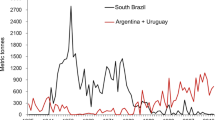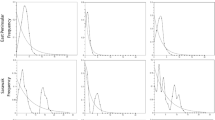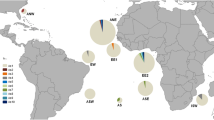Abstract
The depletion of shallow-water fish stocks through overexploitation has led to increasing fishing pressure on deep-sea species. Poor knowledge of the biology of commercially valuable deep-water fish has led to the serial depletion of stocks of several species across the world. Data regarding the genetic structure of deep-sea fish populations is important in determining the impact of overfishing on the overall genetic variability of species and can be used to estimate the likelihood of recolonisation of damaged populations through immigration of individuals from distant localities. Here the genetic structure of the commercially fished deep-water species the blackspot sea bream, Pagellus bogaraveo is investigated in the northeastern Atlantic using partial DNA sequencing of mitochondrial cytochrome b (cyt-b) and D-loop regions and genotyping of microsatellite loci. An absence of variation in cyt-b and low genetic variation in D-loop sequences potentially indicate that P. bogaraveo may have undergone a severe bottleneck in the past. Similar bottlenecks have been detected in other Atlantic species of fish and have possibly originated from the last glaciation. P. bogaraveo may have been particularly vulnerable to the effects of low temperature and a fall in sea level because stages of its life history occur in shallow water and coastal sites. However, there are other explanations of low genetic variability in populations of P. bogaraveo, such as a low population size and the impacts of fishing on population structure. Analysis of population structure using both D-loop and microsatellite analysis indicates low to moderate, but significant, genetic differentiation between populations at a regional level. This study supports studies on other deep-sea fish species that indicate that hydrographic or topographic barriers prevent dispersal of adults and/or larvae between populations at regional and oceanographic scales. The implications for the management and conservation of deep-sea fish populations are discussed.


Similar content being viewed by others
References
Adams J, Maslin M, Thomas E (1999) Sudden climate transitions during the Quaternary. Prog Phys Geogr 23:1–36
Bailey KM, Stabeno PJ, Powers DA (1997) The role of larval retention and transport features in the mortality and potential gene flow of the walleye pollack. J Fish Biol 51 (Suppl A):135–154
Baker CS, Perry A, Chambers GK, Smith PJ (1995) Population variation in the mitochondrial cytochrome b gene of the orange roughy Hoplostethus atlanticus and the hoki Macruronus novaezelandiae. Mar Biol 122:503–509
Bargelloni L, Alarcon JA, Alvarez MC, Penzo E, Margoulas A, Reis C, Patarnello T (2003) Discord in the family Sparidae (Teleostei): divergent phylogeographical patterns across the Atlantic–Mediterranean divide. J Evol Biol 16:1149–1158
Barton NH (2000) Genetic hitchhiking. Philos Trans R Soc Lond B Biol Sci 355:1553–1562
Bernatchez L, Dodson JJ, Bolvin S (1989) Population bottlenecks—influence on mitochondrial-DNA diversity and its effect on coregonine stock discrimination. J Fish Biol 35 (Suppl A):233–244
Bossart JL, Prowell DP (1998) Genetic estimates of population structure and gene flow: limitations, lessons and new directions. Trends Ecol Evol 13:202–206
Carr SM, Snellen AJ, Howse KA, Wroblewski JS (1995) Mitochondrial DNA sequence variation and genetic stock structure of Atlantic cod (Gadus morhua) from bay and offshore locations on the Newfoundland continental shelf. Mol Ecol 4:79–88
Carvalho GR, Hauser L (1995) Molecular genetics and the stock concept in fisheries. In: Carvalho GR, Pitcher TJ (eds) Molecular genetics in fisheries. Chapman & Hall, London, pp 55–79
Clark MR (1995) Experience with the management of orange roughy (Hoplostethus atlanticus) in New Zealand and the effects of commercial fishing on stocks over the period 1980–1993. In: Hopper AG (ed) Deep-water fisheries of the North Atlantic oceanic slope. Kluwer, Dordrecht, pp 251–266
Clement M, Posada D, Crandall KA (2000) TCS: a computer program to estimate gene genealogies. Mol Ecol 9:1657–1659
Creasey S, Rogers AD (1999) Population genetics of bathyal and abyssal organisms. Adv Mar Biol 35:1–151
Desdevises Y, Jovelin R, Jousson O, Morand S (2000) Comparison of ribosomal DNA sequences of Lamellodiscus spp. (Monogenea, Diplectanidae) parasitising Pagellus (Sparidae, Teleostei) in the north Mediterranean Sea: species divergence and coevolutionary interactions. Int J Parasitol 30:741–746
Donaldson KA, Wilson RR (1999) Amphi-panamic geminates of snook (Percoidei: Centropomidae) provide a calibration of the divergence rate in the mitochondrial DNA control region of fishes. Mol Phylogen Evol 13:208–213
Duschenko VV (1988) The formation of the commercial stock of the north Atlantic grenadier. Can Transl Fish Aquat Sci 5340:1–21
D’yakov YP (1991) Population structure of Pacific black halibut, Reinhardtius hippoglossoides. J Icthyol 31:16–28
Excoffier L, Smouse PE, Quattro JM (1992) Analysis of molecular variance inferred from metric distances among DNA haplogroups: applications to human mitochondrial DNA restriction data. Genetics 131:479–491
Fauvelot C, Bernardi G, Planes S (2003) Reductions in the mitochondrial DNA diversity of coral reef fish provide evidence of population bottlenecks resulting from Holocene sea-level change. Evolution 57:1571–1583
Fenton GE, Short SA, Ritz DA (1991) Age determination of orange roughy, Hoplostethus atlanticus (Pisces: Trachichthyidae) using 210Pb:226Ra disequilibria. Mar Biol 109:197–202
Frankham R, Ballou JD, Briscoe DA (2002) Introduction to conservation genetics. Cambridge University Press, Cambridge
Garcia de Leon F, Chikhi JL, Bonhomme F (1997) Microsatellite polymorphism and population subdivision in natural populations of European sea bass Dicentrachus labrax (Linnaeus, 1758) Mol Ecol 6:51–62
Gianni M (2004) High seas bottom fisheries and their impact on the biodiversity of vulnerable deep-sea ecosystems: summary findings. Report to the World Conservation Union, World Wildlife Fund and Natural Resources Defence Council. IUCN, Gland, Switzerland, pp 1–83
Glenn TC, Stephan W, Braun MJ (1999) Effects of a population bottleneck on whooping crane mitochondrial DNA variation. Conserv Biol 13:1097–1107
Grant WS, Bowen BW (1998) Shallow population histories in deep evolutionary lineages of marine fishes: insights from sardines and anchovies and lessons for conservation. J Hered 89:415–428
Guo S, Thompson E (1992) Performing the exact test of Hardy-Weinberg proportion for multiple alleles. Biometrics 48:361–372
Haedrich RL (1995) Structure over time of an exploited deepwater fish assemblage. In: Hopper AG (ed) Deep-water fisheries of the North Atlantic oceanic slope. Kluwer, Dordrecht, pp 70–96
Hoarau G, Borsa P (2000) Extensive gene flow within sibling species in the deep-sea fish Beryx splendens. C R Acad Sci Sci Vie 323:315–325
Jean C, Hui C, Lee S, Chen C (1995) Variation in the mitochondrial DNA and phylogenetic relationships of fish of the subfamily Sparinae (Perciformes: Sparidae) in the coastal waters of Taiwan. Zool Stud 34:270–280
Karrer C (1984) Beschreibung von Jungenstadien dreier Spariden-Arten aus dem nordwest-afrikanischen Auftriebsgebeit (Teleostei, Perciformes). Arch Fisch Wissenschaft 35:53–90
Kocher TD, Thomas WK, Meyer A, Edwards SV, Paabo S, Wilson AC (1989) Dynamics of mitochondrial DNA evolution in animals: amplification and sequencing with conserved primers. Proc Natl Acad Sci U S A 86:6169–6200
Koslow JA, Boehlert GW, Gordon JDM, Haedrich RL, Lorance P, Parin N (2000) Continental slope and deep-sea fisheries: implications for a fragile ecosystem. ICES J Mar Sci 57:548–557
Krug H (1998) Variation in the reproductive cycle of the black spot seabream, Pagellus bogaraveo (Brünnich, 1768) in the Azores. Arquipelago Bull Univ Azores Life Mar Sci 16A:37–47
Mace PM, Fenaughty JM, Coburn RP, Doonan IJ (1990) Growth and productivity of orange roughy (Hoplostethus atlanticus) on the north Chatham Rise. N Z J Mar Freshw Res 24:105–119
Martin AP, Humphreys R, Palumbi SR (1992) Population genetic structure of the armourhead, Pseudopentaceros wheeleri, in the North Pacific Ocean: application of the polymerase chain reaction to fisheries populations. Can J Fish Aquat Sci 49:2368–2391
Martin AP, Palumbi SR (1993) Body size, metabolic rate, generation time, and the molecular clock. Proc Natl Acad Sci U S A 90:4087–4091
McCarthy C (1998) Chromas, ver 1.45. Available at: http://www.technelysium.com.au/chromas14x.html
Menezes G, Rogers A, Krug H, Mendonça A, Stockley BM, Isidro E, Pinho MR, Fernandes A (2001) Seasonal changes in biological and ecological traits of demersal and deep-water fish species in the Azores. Final Report European Commission DGXIV/C/1 Contract 97/081. University of the Azores, Faial, Azores, Portugal, pp 1–162 plus appendices
Milton DA, Shaklee JB (1987) Biochemical genetics and population structure of blue grenadier, Macruronus novaezelandiae (Hector) (Pisces: Merluccidae), from Australian waters. Aust J Mar Freshw Res 38:727–742
Mix AC, Bard E, Schneider R (2001) Environmental processes of the ice age: land, oceans, glaciers (EPILOG). Quatern Sci Rev 20:627–657
Mulligan TJ, Chapman RW, Brown BL (1992) Mitochondrial DNA analysis of walleye Pollack, Theragra chalcogramma, from the eastern Bering Sea and Shelikof Strait, Gulf of Alaska. Can J Fish Aquat Sci 49:319–326
Muss A, Robertson DR, Stepien CA, Wirtz P, Bowen BW (2001) Phylogeography of Ophioblennius: the role of ocean currents and geography in reef fish evolution. Evolution 55:561–572
Nei M (1987) Molecular evolutionary genetics. Columbia University Press, New York
Nurminsky DI (2001) Genes in sweeping competition. Cell Mol Life Sci 58:125–134
O’Connell M, Dillon MC, Wright JM, Bentzen P, Merkouris S, Seeb J (1998) Genetic structure among Alaskan Pacific herring populations identified using microsatellite variation. J Fish Biol 53:150–163
Ostellari L, Bargelloni L, Penzo E, Patarnello P, Patarnello T (1996) Optimization of single-strand conformation polymorphism and sequence analysis of the mitochondrial control region in Pagellus bogaraveo (Sparidae, Teleostei): rationalized tools in fish population biology. Anim Genet 27:423–427
Palumbi SR, Martin A, Romano S, McMillan WO, Stice L, Grabowski G (1991) The simple fools guide to PCR, ver 2.0. Kewalo Marine Laboratory, University of Hawaii, Honolulu
Pogson GH, Mesa KA, Boutillier RG (1995) Genetic population structure and gene flow in the Atlantic cod Gadus morhua: a comparison of allozyme and nuclear RFLP loci. Genetics 139:375–385
Richardson LR, Gold JR (1997) Mitochondrial DNA diversity in and population structure of the red grouper, Epinephelus morio, from the Gulf of Mexico. Fish Bull 95:174–179
Rogers AD (1994) The biology of seamounts. Adv Mar Biol 30:305–350
Rogers AD (1999) The biology of Lophelia pertusa (Linnaeus 1758) and other deep-water reef-forming corals and impacts from human activities. Int Rev Hydrobiol 84:315–406
Rogers AD (2003) Molecular ecology and evolution of slope species. In: Wefer G, Billett D, Hebbeln D, Jørgensen B, Schlüter M, Weering T van (eds) Ocean margin systems. Springer, Berlin Heidelberg New York, pp 323–337
Ruddiman WF, McIntyre A (1981) The north Atlantic Ocean during the last glaciation. Palaeogeogr Palaeoclimatol Palaeoecol 35:145–214
Ruzzante DE (1998) A comparison of several measures of genetic distance and population structure with microsatellite data: bias and sampling variance. Can J Fish Aquat Sci 55:1–14
Sambrook J, Fritscher EF, Maniatis T (1989) Molecular cloning: a laboratory manual. Cold Spring Harbor Laboratory Press, New York
Sasaki T (1986) Development and present status of Japanese trawl fisheries in the vicinity of seamounts. In: Uchida RN, Hayasi S, Boehlert GW (eds) Proceedings of the workshop on the environment and resources of seamounts in the North Pacific. U.S. Department of Commerce, NOAA Tech Rep NMFS 43:31–35
Schlötterer C (1998) Microsatellites. In: Hoelzel AR (ed) Molecular genetic analysis of populations: a practical approach, 2nd edn. IRL Press/Oxford University Press, Oxford, pp 237–261
Schneider S, Roessli D, Excoffier L (2000) Arlequin: a software for population genetics data analysis, ver 2.000. Genetics and Biometry Lab, Dept. of Anthropology, University of Geneva
Sedberry GR, Carlin JL, Chapman RW, Eleby B (1996) Population structure in the pan-oceanic wreckfish Polyprion americanus (Teleostei: Polyprionidae), as indicated by mtDNA variation. J Fish Biol 49 (Suppl A):318–329
Slatkin M (1991) Inbreeding coefficients and coalescence times. Genet Res 58:167–175
Slatkin M (1995) A measure of population subdivision based on microsatellite allele frequencies. Genetics 139:457–462
Smith PJ, Francis RICC (1982) A glucosephosphate isomerase polymorphism in New Zealand ling Genypterus blacodes. Comp Biochem Physiol 73B:451–455
Spradling TA, Hafner MS, Demastes JW (2001) Differences in the rate of cytochrome-b evolution among species of rodents. J Mammal 82:65–80
Stammatis C, Triantafyllidis A, Moutou A, Mamuris Z (2004) Mitochondrial DNA variation in northeast Atlantic and Mediterranean populations of Norway lobster, Nephrops norvegicus. Mol Ecol 13:1377–1390
Stepien CA (1999) Phylogeographic structure of the Dover sole Microstomus pacificus: the larval retention hypothesis and genetic divergence along the deep continental slope of the northeastern Pacific Ocean. Mol Ecol 8:923–939
Stockley BM, Rogers AD, Iyengar A, Menezes G, Santos R, Long A (2000) Ten microsatellite loci isolated and developed for the blackspot seabream, Pagellus bogaraveo (Brünnich 1768). Mol Ecol 9:999–1000
Tajima F (1983) Evolutionary relationship of DNA sequences in finite populations. Genetics 105:437–460
Thompson JD, Gibson TJ, Plewniak F, Jeanmougin F, Higgins DG (1997) The CLUSTAL_X windows interface: flexible strategies for multiple sequence alignment aided by quality analysis tools. Nucleic Acids Res 25:4876–4882
Vis ML, Carr SM, Bowering WR, Davidson WS (1997) Greenland halibut (Reinhardtius hippoglossoides) in the North Atlantic are genetically homogenous. Can J Fish Aquat Sci 54:1813–1821
Waldman JR, Bender RE, Wirgin II (1998) Multiple population bottlenecks and DNA diversity in populations of wild striped bass, Morone saxatilis. Fish Bull 96:614–620
Ward RD, Elliot NG, Grewe PM, Last PR, Lowry PS, Innes BH, Yearsley GK (1998) Allozyme and mitochondrial DNA variation in three species of oreos (Teleostei: Oreosomatidae) from Australian waters. N Z J Mar Freshw Res 32:233–245
Weber DS, Stewart BS, Garza JC, Lehman N (2000) An empirical genetic assessment of the severity of the northern elephant seal population bottleneck. Curr Biol 10:1287–1290
Whitlock M, McCauley D (1999) Indirect measures of gene flow and migration: FST doesn’t equal 1/(4Nm+1). Heredity 82:117–125
Wright S (1931) Evolution in Mendelian populations. Genetics 16:97–159
Wright S (1951) The genetical structure of populations. Ann Eugen 15:323–354
Acknowledgements
This study was funded by the European Commission DGXIV/C/1 as study contract 97/081 “Seasonal changes in biological and ecological traits of demersal and deep-water fish species in the Azores”. The authors wish to thank the crew of the “R.V. Arquipélago” for invaluable help and commitment during the sampling for this investigation and Maria Aboim for assistance with sampling on the Portuguese mainland. We also acknowledge provision of facilities for this work by Prof. Ricardo Santos, Departamento Oceanografica e Pescas, University of the Azores, Faial Island; Prof. Patrick Holligan at the School of Ocean & Earth Science, University of Southampton, Southampton Oceanography Centre; Professor Christopher Rapley, British Antarctic Survey. Special thanks for technical assistance and help with laboratory work are due to Mark Dixon, School of Biological Science, University of Southampton, and members of the Molecular Ecology Research Group Ex. School of Ocean & Earth Science, University of Southampton.
Author information
Authors and Affiliations
Corresponding author
Additional information
Communicated by J.P. Thorpe, Port Erin
Rights and permissions
About this article
Cite this article
Stockley, B., Menezes, G., Pinho, M.R. et al. Genetic population structure in the black-spot sea bream (Pagellus bogaraveo Brünnich, 1768) from the NE Atlantic. Marine Biology 146, 793–804 (2005). https://doi.org/10.1007/s00227-004-1479-3
Received:
Accepted:
Published:
Issue Date:
DOI: https://doi.org/10.1007/s00227-004-1479-3




